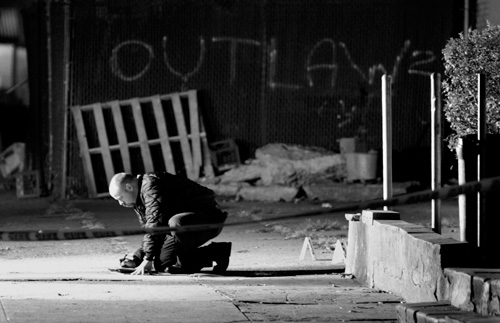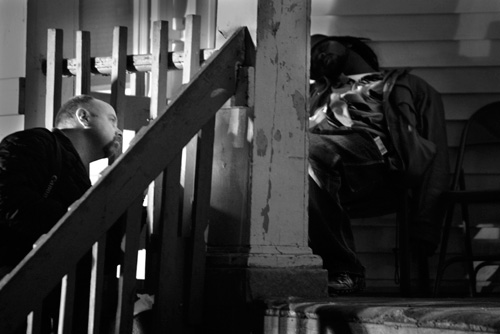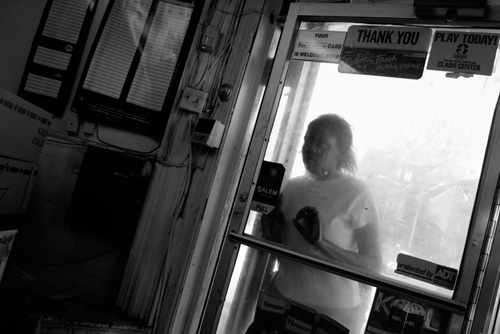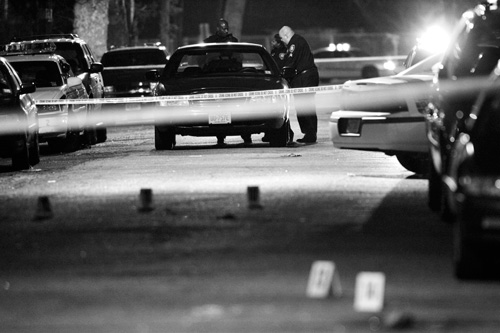Evidence of a crisis
The Star-Ledger, January 30, 2006
Long hours and sloppy errors plague crime scene unit

A dark street corner. A shooting victim lies dead on the pavement. Someone calls the cops.
Among the first to arrive is a crime scene investigator, whose job is to look for clues: blood, bullets, sweat, hair, skin, clothing, fingerprints. But this is not television’s “CSI,” where teams of high-tech sleuths drive up in gleaming Hummers and use the latest in technology to tie killers to their crimes.
This is Essex County, where a single member of the prosecutor’s Crime Scene Unit arrives in an old Chevy Tahoe and returns to a dingy garage in Newark where there is no e-mail and the only running water is in the bathroom.
In this real-life hunt for a killer, the ill-equipped and overworked crime scene investigator sometimes misses potential evidence, forgets to test evidence, or misplaces evidence. Lawyers and law enforcement officials say these failures often are why murderers in Essex County go unpunished more often than they are sent to prison, as a Star-Ledger analysis of homicides reveals. There were 637 killings in the county from 1998 through 2003, and someone was convicted in only 296 of those cases, The Star-Ledger found.
“The Essex County Crime Scene Unit is underfunded and disorganized, and its people are undertrained and overloaded with work,” said defense attorney Joseph Ferrante. “They’re sloppy. There’s no good set of procedures. In short, there’s a lot of fodder for defense attorneys to create doubt.”
Naturally, defense attorneys feast on the flaws.
They play to juries every time there are no fingerprints, no DNA or, as in some cases, no forensic evidence at all. And, of course, they can’t wait for cases like Jamaine Smith’s. Smith was acquitted of double-murder charges after investigators failed to find any physical evidence from the bloody basement where Derrick Pressley and Diane Harden were shot to death in Newark in March 2002.
Pressley’s sister, Jenine, watched the case unravel at trial in May 2004. “How can you not come up with one piece of evidence at the scene of a double homicide, not even footprints, nothing at all?” she asked. “There was minimum effort made to solve this doggone crime.”

TOPPLED CASE FILES
By almost any measure, the members of the Crime Scene Unit, a part of the Essex County Prosecutor’s Office since 1993, are underdogs.
While none of the unit’s investigators would be quoted for this story, other law enforcement officials and internal documents describe a squad that is lacking the staffing, equipment, office space and procedures to do the job right.
The five-member unit handles about 400 cases a year, including homicides — there were 146 in 2005 — police shootings, suspicious deaths and, until recently, carjackings. Two members had no police investigative experience when they were hired. Only one of the investigators has been with the unit for more than 18 months.
They are led by a supervising lieutenant and have one clerical worker to help around the office.
By comparison, Somerset County, the location of three homicides in 2005, has four people in its Crime Scene Unit — two sergeants and two detectives. Middlesex County, where there were 10 killings last year, has four crime scene investigators. And Hudson County, where there were 49 homicides in 2005, has a six-member unit.
Then there’s the matter of working conditions.
The Essex CSU works from a former parking garage in downtown Newark. Members of the Prosecutor’s Office refused to allow a reporter or photographer inside the building. But staffers and internal documents suggest a scene in which bags of evidence are frequently piled in the hallway while case files lay toppled over in an adjacent room.
There’s no trash pickup or cleaning service. The electrical circuits blow out regularly. In winter, investigators rely on space heaters to keep warm. The only source of water is the bathroom, so it sometimes doubles as an evidence-processing area.
“It is simply unacceptable how our crime scene operation is expected to operate today, given its secondhand facility,” Essex County Prosecutor Paula Dow said.
On nights and weekends, when most murders in Essex County occur, only one investigator is on call — although in some cases lately, the members have taken it upon themselves to make sure a second person visits the scene.
“They’re so inundated with violent crime and physical evidence, I don’t think each individual investigator is able to do everything that can be done from a crime scene standpoint,” said State Police Detective Sgt. Howie Ryan, a crime scene investigator who often works with the Essex unit. “To have one person on call is not practical.
They need more.”
During the week, investigators sprint from crime scene to autopsy to witness stand, just trying to keep up.
Any misstep in collecting, preparing or presenting evidence for a trial, lawyers said, can be crippling to the prosecution because juries, in what’s known as “the CSI effect,” expect things to work the way they do on television.
“When law enforcement is not careful to look for every piece of evidence when someone is facing 30 years to life, jurors are willing to give that person the benefit of the doubt,” said Newark attorney Paul Bergrin, who has successfully represented many murder defendants. “The jurors seem to be interested in scientific testing, and they expect investigators to do a proper job.”
In the past 19 months, two Essex investigators have left for jobs in Somerset and Middlesex counties, where the caseloads are lighter, the pay is higher and the working conditions better. Of the two new investigators who replaced them, one is seeking transfer to another job in the Prosecutor’s Office.
“No doubt, CSU is understaffed,” Tim Braun, a retired Essex County homicide investigator, said. “That does in a homicide investigation. It rushes you to do your job.
“When you rush, you miss things.”

BAD START
The bungled investigation into the March 2002 murders of Derrick Pressley and his girlfriend, Diane Harden, as described in newspaper coverage of the trial and in recollections by a defense lawyer, illustrates how a botched crime scene investigation can help sink a murder case.
Just before the couple were shot to death in a basement of a house in Newark’s Fairmount section, where Pressley trained pit bulls, a neighbor heard him begging for his life.
Deborah Williams, who lived upstairs, testified she heard Jamaine Smith and Pressley arguing and Smith saying, “I’m going to settle this once and for all.”
Pressley, a 33-year-old pet store owner and aspiring rapper, begged, “Don’t do this, don’t do this.”
Then Williams heard gunshots. She said she peeked out her window blinds to watch Smith get into a van and leave.
Investigators said they believe Harden was shot because she was a witness.
Bergrin, who represented Smith, said the murder scene included signs of a struggle. Yet investigators took no samples from a bloodstain on the floor, he said. They neglected to check Smith’s clothing for dog hairs or fibers. They clipped the victims’ fingernails but never sent them for analysis.
“They didn’t test for anything,” Bergrin said.
Smith spent the four days following the homicides in a motel. After police arrested him, he said that he had been home, across town from the killings, when they occurred.
Paul Bradley, the assistant prosecutor who handled the case, said checking Smith’s clothing for fibers or hair would have been pointless because Smith had made several previous visits to the Fairmount house. Bradley also said there was no sign of a struggle or any indication the killer bled at the scene.
“There were no forensics that could be obtained in this case,” Bradley said.
Bergrin said the lack of evidence left the prosecution’s witness open to attack. “They should have done everything in their power to place the defendant in the area of the basement where the victims were found,” Bergrin said.
During the trial, Bergrin whittled away at Williams’ credibility by pointing out discrepancies in her earlier statements to authorities. Another witness said she saw Smith enter and leave the house but admitted she never saw his face. And three defense witnesses, including an ex-girlfriend who said she stayed with Smith in the motel room, came forward to testify he had been at home with them during the slayings.
After six hours of deliberations, the jury found Smith not guilty.
The victims’ relatives staggered out of the courtroom in shock.
They took some solace in the fact Smith had been sent to prison on an unrelated drug charge. But in July, the state sent a letter to Pressley’s mother, Loretta, that said Smith had been released.
“I felt so disappointed, I just threw it in the garbage,” she said.

DAMNING REPORTS
Many of the CSU’s failings were outlined recently in a series of internal reports prompted by allegations one of its most experienced investigators, John Cosgrove, stole cash from a murder victim.
Around the time Cosgrove came under suspicion in the spring of 2004, Lt. Stephen E. Bright, the unit’s supervisor, complained to superiors in the Prosecutor’s Office about working conditions.
In a report to Deputy Chief Frank J. Rogers in April 2004, Bright wrote that the CSU was operating with “borrowed and antiquated equipment” under unsafe conditions. He added he was worried an investigator might get hurt or miss an important piece of evidence while “going through the motions of the job.”
“Unlike most of the other crime scene units throughout the state, this unit is not afforded the luxury of time, equipment and manpower on every homicide,” Bright wrote in the report, which was obtained by The Star-Ledger. “Nonetheless, it is expected to do the job in exemplary fashion, and, in spite of a rudimentary existence, often does.” Rogers dispatched internal affairs investigator Michael Critelli. In a May 2004 memo to his boss, Critelli described a unit in disarray.
Critelli, who like Bright declined to be interviewed for this story, reported evidence was stored in hallways that lacked surveillance cameras, fire equipment or alarms. Evidence was poorly labeled and often left in stacks rather than turned over to authorities for use in investigations. Guns weren’t safely secured.
The memo, which was obtained by The Star-Ledger, went on to say there was no computer system to track evidence or to document what had been taken for testing or use at a trial.
At the end of his list of deficiencies, Critelli noted the unit suffered from “lack of command and control.”

BOUND FOR ORANGE
For an idea of what her CSU unit should look like, Dow needs only to walk across town.
The FBI’s new Newark office is home to a 30-member crime scene unit with state-of-the-art equipment. The squad assists county authorities on difficult investigations, but only when asked. In the past year, it responded to two high-profile murders in Jersey City; Essex rarely seeks its help, federal and county officials said.
In suburban Somerset County, the Crime Scene Unit is undergoing a multimillion-dollar renovation that will allow investigators to perform tests using changing-wavelength light, chemicals, computers and digital video cameras in contamination-free rooms.
Dow said she also wants a new headquarters that will bring the Essex CSU into the modern age. The unit “should be second to none, yet it remains in what is surely one of the most inadequate facilities in the state,” Dow wrote in her annual budget request to County Executive Joseph DiVincenzo in October.
DiVincenzo and Dow’s top staffers say they are now renovating a county-owned building in Orange to meet the CSU’s needs. They said they had planned to have the new headquarters ready next month but it likely will take longer because of the time it takes to find the money to buy and install new laboratory equipment. The budget for the new facility, including lab equipment, is $415,605, according to Dow’s office.
“They need more space and they want to make sure the stuff they have is protected and secured, and this place will do that,” DiVincenzo said.

NEW POLICIES
When Critelli, the internal affairs investigator, filed his report on the CSU, he included recommendations to improve operations. They included the immediate processing and return of evidence to local police, new systems to track and file evidence, new vaults and lockers to properly guard seized evidence, and annual audits of the unit.
The captain in charge of the unit, Robert Carella, responded with an interim policy outlining how to track evidence and keep money secure. Dow followed with a policy formalizing CSU operating procedures, and she says she has ended the problems with storing and tracking evidence. A couple of months ago, the unit acquired two new digital cameras.
But investigators say the old problems persist. A newly hired investigator is now in the process of transferring out, forcing the county to find and train another inexperienced replacement.